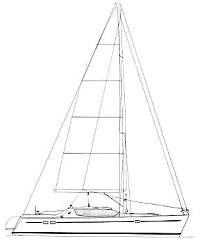Wauquiez 40
Cruiserr
Half models: My old pal Scott Chambers walked in the other day with my newest half model. Built 3/4-inch to the foot scale, this big model of a 69-footer is spectacular and a wonderful reflection of the nautical model maker's craft. After some hemming and hawing we found the perfect place on the wall for the new model alongside the other 59 half models I own. That's right. I own 60 half models. They make great gifts, look good on the wall and can document the boats you have owned over the years in a unique way. There are several very competent model makers in the country. Call your favorite today and order a couple. There's something very comforting about them.
Face it. Raised-saloon boats-Wauquiez calls this one a "pilot saloon"-are "in" today. I think just about everybody likes the light and sense of airiness that you get with a raised saloon. Still this comes at a price since windage and weight are increased while useable interior volume is decreased.
"Huh?" That's right. When you raise the cabin sole in way of the raised saloon you lose the volume available under the side decks. It's still there but the distance from cabin sole to underside of side deck is no longer enough for sitting headroom. This means that in way of the raised saloon the accommodations will be pinched in as can be seen in this 40-footer. Note how the starboard dinette is pushed inboard. On the port side the galley will be right up against the house side and there will be no volume outboard of the counter for standard galley lockers. These are not insurmountable problems, but they do add to the design challenge.
Now balance, if you can, that set of compromises against the benefits of being able to sit at the dinette with your eye level to the middle of the big windows. This means no more of that "down in the cave" feeling you find in many boats. You can sit inside reading on that drizzly, late summer's day and watch the boats come and go without leaving your seat.
A feature that, for many, is worth the price of losing some interior volume.
I don't like the galley I see in the drawings. Of course, this opinion might change if I were to go aboard the boat, but on paper I don't like it. The counter space is over the icebox, and it's forward and down a level from the rest of the galley. It may be that in reality this poses no obstacle at all during cooking. But I need all the help I can get while cooking, and today while nursing three impressive blisters on my right hand from grabbing a hot pan while browning pork loins, I can tell you with certainty that I would prefer all cooking to be on one level. It's manly to forgo the hot pad.
This rig is essentially the same rig that I used on my Saga 43, sans sprit. The idea is that you carry all your headsail compliment permanently on roller furling gear. The outer jib, in this case, is a high-clewed genoa. I'm not sure why the clew is so high unless it has something to do with maintaining the same sheet lead as the sail is rolled up. Note that on the sailplan it shows the outer genoa lead quite far forward indicating that perhaps this genoa is only a reaching sail.
The hull and appendages are pretty standard. This hull is quite similar to the Beneteau. The L/B is 3.09 so this design is also beamy. In this case there is a 6-foot, 6-inch keel in addition to the shoal keel at 5 feet, 5 inches. The shoal keel has an additional 885 pounds of lead. The D/L is 208.
I don't think this boat will win any beauty contests. In fact, I don't think any raised saloon or pilot saloon types would win. Low profiles almost always look better. However, given the design challenges associated with raised saloons I find this a rather good-looking, well proportioned boat.

Comments